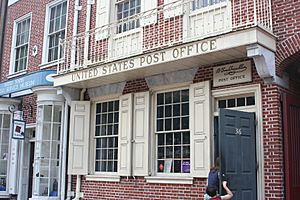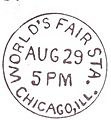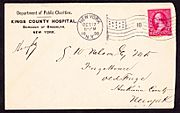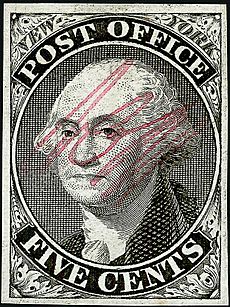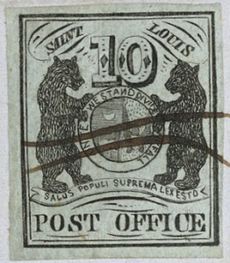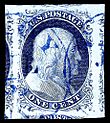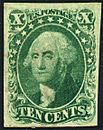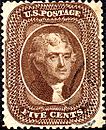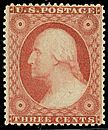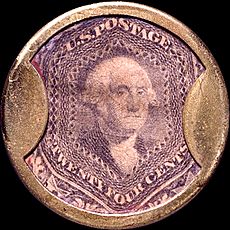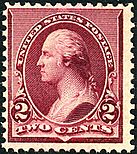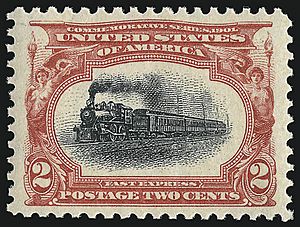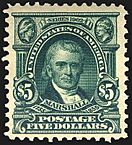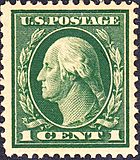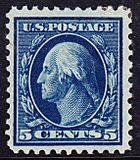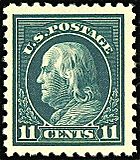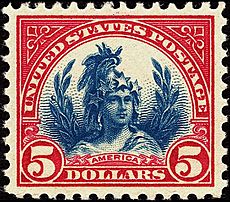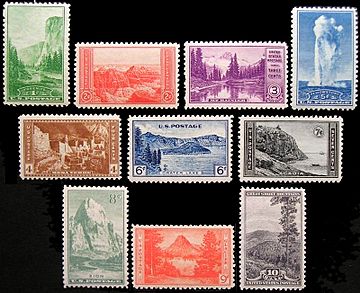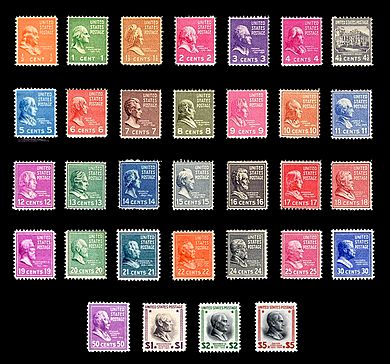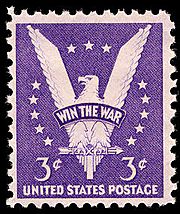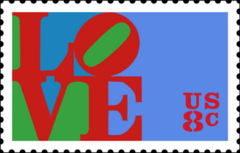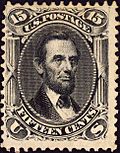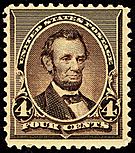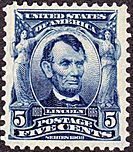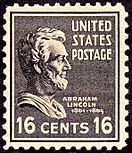Postage stamps and postal history of the United States facts for kids
Postal service in the United States started a long time ago with letters that the person receiving them had to pay for. Later, people began paying for letters before sending them, using private mail carriers and local post offices. Eventually, a system was created where everyone had to use special postage stamps issued by the government.
In the very beginning, if a ship captain arrived in port with letters, they would put ads in the local newspaper. These ads would tell people who had mail to come and pick it up and pay for it. Mail delivery in the U.S. was pretty disorganized until after the American Revolutionary War, when a national postal system was finally set up.
The old ways of sending mail, like letters paid for by the receiver and private postal systems, slowly disappeared after the U.S. government started issuing adhesive postage stamps. The first stamps came out on July 1, 1847, in 5-cent and 10-cent values. By 1855, it became mandatory to use stamps.
Throughout the 1800s, most stamps were used for regular first-class mail. These stamps usually showed the face of an American president or another important historical figure. However, in the 1890s, the Post Office realized they could make more money by selling stamps as "collectibles." So, they started issuing commemorative stamps. These first celebrated big national events, and later, important anniversaries in American history.
As technology improved, special stamps were introduced for things like airmail, zeppelin mail, registered mail, and certified mail. There were also postage due stamps for letters that didn't have enough postage. The post office would stick these on, and the person receiving the letter would pay the mail carrier.
Today, many stamps are self-adhesive, meaning you don't have to lick them. Sometimes, post office workers even use computer-printed labels called Postal Value Indicators (PVI) instead of stamps. For a long time, stamps always showed their value (like 5 cents or 10 cents). But now, the United States Postal Service sells "forever stamps" for regular and international mail. These stamps are always valid, even if the price of postage goes up! However, stamps with specific values are still available for other uses.

Contents
- Early Mail in America
- Post Offices and Postmarks
- Mail Before Stamps
- First Stamps from Postmasters
- First National Postage Stamps
- Stamps During the Civil War
- Grills on Stamps
- Stamps of 1869
- Columbian Issue
- Bureau Issues
- Early 20th Century Stamps
- Stamps of 1902–1903
- Commemorative Stamps, 1904–1907
- Washington-Franklin Era Stamps
- The 1920s and 1930s Stamps
- Famous Americans Series of 1940
- World War II Stamps
- After World War II
- Air Mail Stamps
- Abraham Lincoln Stamps
- Modern U.S. Stamps
- Timeline of U.S. Postal History
- See also
Early Mail in America
Mail services in America started in the early 1600s, serving the first British and French colonies. Today, the United States Postal Service is a huge government group that delivers mail all across the U.S. and its territories.
In the American colonies, informal mail routes run by independent people began in Boston as early as 1639. Service between Boston and New York City started in 1672. Courier service between Montreal and Quebec City began by 1693, and probably even earlier.
Official mail service began in 1692 when King William III of England gave an English nobleman a special "patent." This patent gave him the exclusive right to set up and collect a formal postal tax on all official documents. Years later, in 1765, a tax that required people to buy stamps (either printed directly on documents or on paper to be attached) helped start the American Revolution. This tax was removed a year later, and not many stamps were actually used in the colonies.
Before the American Revolution, mail routes connected cities like Boston, New York, Philadelphia, Montreal, and Quebec City. Important people like Benjamin Franklin and William Goddard were the colonial postmasters. They helped create a postal system that was an alternative to the British "Crown Post." As the Revolution got closer, people trusted the Crown Post less and less. The postal system that Franklin and Goddard built became the model for the new U.S. Post Office. Its basic ideas are still used by the United States Postal Service today.
Post Offices and Postmarks
In 1775, Benjamin Franklin became the first Postmaster General, and that's when the U.S. Post Office officially began. The Postmaster General position was so important that by 1829, it became part of the President's Cabinet. As America grew and new towns appeared, so did post offices. The dates and marks from these post offices, called postmarks, often give historians clues about different times and places in history. Each postmark is unique, showing the name of the state and town, plus the date.
Post offices located along railroad lines and at military bases also have special historical importance. Mail and postmarks from Civil War prisoner of war camps or from naval ships (which had their own U.S. Post Offices) have given amazing insights into U.S. history. Historians and collectors love to find these.
Between 1874 and 1976, post offices were grouped into four classes based on how much money they made, with first class being the highest.
Mail Before Stamps
Before stamps were invented, the person receiving the mail usually paid the postage cost. They would give the money directly to the postman when the letter was delivered. Collecting money for every letter really slowed down the postman. Also, sometimes people would refuse to accept a letter, and then it had to be taken back to the Post Office. It was rare for the sender to pay in advance, and that usually meant a trip to the Post Office. Some people could have a "charge account" for their mail, but keeping track of these accounts was also inefficient.
Postage stamps changed everything, making it common for senders to pay in advance. But for stamps to work well, mail prices had to be the same across the country. If prices were different everywhere, postal workers would still have to spend time figuring out the cost for each letter, which would make stamps less useful.
First Stamps from Postmasters
The idea of postage stamps started in the UK in May 1840 and got a lot of attention in the United States. Later that year, Daniel Webster suggested to the U.S. Senate that America should also use standardized rates and postage stamps.
However, it was a private company that first brought stamps to the U.S. On February 1, 1842, a new delivery service called "City Despatch Post" started in New York City. They introduced the first adhesive postage stamp ever made in the Western Hemisphere. This stamp was a 3-cent stamp with a drawing of George Washington. The company also put mailboxes around the city for customers to drop off their letters.
A few months later, the U.S. government bought the City Despatch Post and renamed it the "United States City Despatch Post." The government kept using the original Washington stamp but changed its lettering to show the new name. This made it the first postage stamp produced by a government in the Western Hemisphere.
On July 1, 1845, new laws set standard (and mostly lower) postal rates across the country. For example, a letter traveling under 300 miles cost five cents, and over 300 miles cost ten cents. Even though Congress didn't approve stamps for nationwide use until 1847, local postmasters realized they could now create and sell their own "provisional" stamps for these new standard rates. These provisional stamps were often simple in design. The New York Postmaster's Provisional was one of the best quality ones.
Provisional stamps from Baltimore were special because they had the signature of the city's postmaster, James M. Buchanan. All provisional stamps are rare, and some are extremely valuable. For example, a Millbury provisional stamp sold for $400,000 in 2012, and Alexandria and Annapolis provisional stamps each sold for $550,000. Eleven cities printed provisional stamps in 1845 and 1846:
- Alexandria, Virginia (with "ALEXANDRIA POST OFFICE" in a circle)
- Annapolis, Maryland (with an eagle in a circle)
- Baltimore (with James Buchanan's signature)
- Boscawen, New Hampshire (with "PAID / 5 / CENTS")
- Brattleboro, Vermont (with a shaded box and postmaster initials)
- Lockport, New York (with "LOCKPORT N.Y." in an oval)
- Millbury, Massachusetts (with a woodcut of George Washington)
- New Haven, Connecticut (with "POST OFFICE" in a box and P.M. signature)
- New York City (with "POST OFFICE" over a Washington portrait)
- Providence, Rhode Island (with "POST OFFICE / PROV. R.I." in a shaded box)
- St. Louis (St. Louis Bears, Missouri coat of arms)
The 1845 law actually raised the price for "drop letters" (letters delivered from the same post office where they were sent) from one cent to two cents.
First National Postage Stamps
Congress finally approved the printing of national stamps on March 3, 1847. The Postmaster-General quickly hired a company called Rawdon, Wright, Hatch, and Edson from New York City. The first U.S. stamps went on sale on July 1, 1847, in New York City. Boston got them the next day, and other cities followed.
These first stamps included a 5-cent red-brown stamp showing Benjamin Franklin (who was the first postmaster of the U.S.) and a 10-cent black stamp with George Washington. Like all U.S. stamps until 1857, they were imperforate, meaning they didn't have holes between them and had to be cut apart.
The 5-cent stamp paid for a letter weighing less than half an ounce and traveling up to 300 miles. The 10-cent stamp covered deliveries over 300 miles, or twice the weight for the 5-cent stamp. Both stamps were engraved by hand, probably on steel. The 5-cent stamps often look faded because the ink used had tiny bits of quartz that wore down the printing plates. However, most 10-cent stamps have clear images.
Using stamps was optional at first. Letters could still be sent with the receiver paying the postage. The post office didn't even make a 2-cent stamp for drop letters in 1847, so those continued to be handled the old way. Still, many Americans started using stamps. About 3.7 million 5-cent stamps and 865,000 10-cent stamps were sold. Enough of them still exist today for collectors.
By 1851, the post office was so efficient that Congress lowered the common mail rate to three cents, which stayed the same for over 30 years! This new rate applied to letters traveling up to 3,000 miles. However, this rate was only for prepaid mail. A letter sent without a stamp still cost the receiver five cents. This showed that Congress planned to make stamp use mandatory later (which they did in 1855).
The 1-cent drop-letter rate was also brought back. The post office initially issued only three stamps in the 1851 series: 1-cent, 3-cent, and 12-cent. These went on sale in July and August. Since the 1847 stamps no longer matched any postal rates, they were declared invalid after a short time. People could exchange their old stamps for new ones.
Later, the post office realized they needed stamps in the old denominations again. So, they added a 10-cent stamp to the series in 1855, followed by a 5-cent stamp the next year. The full series included a 1-cent blue stamp of Franklin, a 3-cent red-brown stamp of Washington, a 5-cent portrait of Thomas Jefferson, and 10-cent green and 12-cent black stamps of Washington.
- First national postage stamps
-
Benjamin Franklin Issue of 1851
-
George Washington Issue of 1855
-
Thomas Jefferson Issue of 1857
-
George Washington Issue of 1857
-
George Washington Issue of 1857
In 1857, stamps with perforations (the little holes that make stamps easy to tear apart) were introduced. In 1860, 24-cent, 30-cent, and 90-cent stamps were issued for the first time, again featuring images of Washington and Franklin. These higher value stamps were only available for a little over a year, so they were rarely used. A used 90-cent stamp is very rare and often faked, so collectors are advised to be careful.
In February 1861, a law allowed "cards, blank or printed" to be mailed for one cent per ounce. Private companies soon started making post cards with a rectangle for the stamp. The Post Office didn't produce its own pre-stamped "postal cards" for another 12 years.
The stamps from this period were declared invalid in May 1861 because the Confederate States of America had supplies of them. So, stamps used after that date often have a mark saying "OLD STAMPS/NOT RECOGNIZED."
Stamps During the Civil War
The start of the American Civil War caused a lot of chaos for the postal system. On April 13, 1861, the day after the attack on Fort Sumter, John H. Reagan, the postmaster-general of the Confederate States of America, ordered local postmasters to send their U.S. stamps back to Washington, D.C. (though many probably didn't). In May, the Union decided to cancel all existing U.S. stamps and issue new ones.
Confederate post offices were left without official stamps for several months. Many went back to the old system of cash payments. However, over 100 post offices in the South created their own provisional stamps, many of which are very rare. Eventually, the Confederate government issued its own stamps.
In the North, new stamp designs became available in August. Old stamps could be exchanged for new ones, with different deadlines for different regions. This whole process was confusing for the public. Many letters from 1862 and later still had 1857 stamps and were marked "OLD STAMPS NOT RECOGNIZED."
The 1861 stamps all had the letters "U S" in their design. To make them easy to tell apart from older stamps, all their values were shown in Arabic numerals (the previous series only had Arabic numerals on the 30-cent stamp). The first issue included all the same values as the previous series: 1¢, 3¢, 5¢, 10¢, 12¢, 24¢, 30¢, and 90¢ stamps. Besides the numbers, many of these stamps looked similar to their earlier versions because Franklin, Washington, and Jefferson were still on the same values.
A 2-cent black stamp featuring Andrew Jackson was issued in 1863 and is now known to collectors as the "Black Jack". A black 15-cent stamp showing the recently assassinated Abraham Lincoln was issued in 1866. This is often considered part of the same series. Although it wasn't officially called a memorial stamp, and the 15-cent value was chosen for registered letters, some stamp collectors believe it was the first memorial stamp ever issued.
The war greatly increased the amount of mail in the North. About 1.75 billion copies of the 3-cent stamp were printed. Many have survived and usually sell for a few dollars each. Most are rose-colored; pink versions are much rarer and more expensive.
Unlike the two previous issues, the stamps from the 1861 series remained valid for postage even after newer stamps came out. This has been true for all U.S. stamps since then.
Pony Express Mail

In 1860, the U.S. Post Office used the services of the Pony Express to deliver mail to and from San Francisco. This was very important when the American Civil War started, as a communication link between Union forces and the West Coast was badly needed. The Pony Express Trail from St. Joseph, Missouri, to Sacramento, California, was 1,840 miles long. After arriving in Sacramento, the mail was put on a steamboat and continued down the Sacramento River to San Francisco, making the total journey 1,966 miles.
The Pony Express only operated for 18 months, so there isn't much surviving Pony Express mail today. Only about 250 examples are known to exist.
Encased Postage Stamps
During the Civil War, people started hoarding coins, which caused a shortage of money. This led to stamps being used as currency. However, stamps were too fragile to be passed around. To solve this, John Gault invented the encased postage stamp in 1862. A regular U.S. stamp was wrapped around a small cardboard disc and then placed inside a coin-like brass holder. A clear mica window in the holder allowed the stamp to be seen.
All eight stamp values available in 1861–62 (from 1 cent to 90 cents) were offered in encased versions. The metal backs of the holders often had raised letters advertising businesses, like the Aerated Bread Company or Ayer's Sarsaparilla.
Grills on Stamps
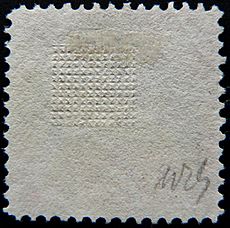
In the 1860s, postal authorities worried about people reusing stamps. Even though there isn't much proof this happened often, many post offices didn't have proper canceling tools. Instead, they would scribble on the stamp with an ink pen (called "pen cancellation") or carve designs into pieces of cork (called "fancy cancels") to mark the stamps. However, if the ink was poor quality, it could be washed off, making this method not very effective. Many inventors tried to solve this problem.
The Post Office eventually started using the grill. This device had a pattern of tiny pyramid-shaped bumps that would press into the stamp, breaking its fibers. This made the ink soak in deeper, making it harder to wash off. There were eleven different types of grills, identified by their size and shape (collectors label them with letters A-J and Z). This practice started around 1867 and was slowly stopped after 1871. Some grilled stamps are among the rarest U.S. stamps. For example, the United States 1¢ Z grill was once thought to be the rarest, with only two known. Later, a 15¢ Z grill was also found, and it's just as rare. Even rarer is the 30¢ stamp with the I Grill; as of 2011, only one copy is known.
Stamps of 1869
In 1868, the Post Office hired the National Bank Note Company to create new stamps with various designs. These stamps came out in 1869 and were special because of their different subjects. For example, the 2¢ stamp showed a Pony Express rider, the 3¢ stamp showed a locomotive, the 12¢ stamp showed the steamship Adriatic, the 15¢ stamp showed Christopher Columbus landing, and the 24¢ stamp showed the signing of the Declaration of Independence.
Other new things in this series, known as the 1869 Pictorial Issue, included the first time U.S. stamps were printed in two colors. This also led to the first invert errors, where part of the stamp was printed upside down. Even though collectors love them today, these unusual stamps were not very popular back then. People were used to stamps that showed classic pictures of Washington, Franklin, and other important figures.
Columbian Issue
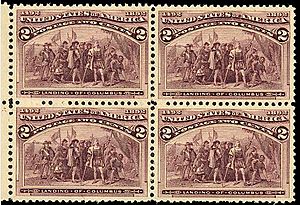
The World's Columbian Exposition in 1893 celebrated 400 years since Christopher Columbus landed in the Americas. The Post Office joined in by issuing a series of 16 stamps. These stamps showed Columbus and events from his life, with values ranging from 1¢ to $5 (which was a lot of money back then!). Many people consider these to be the first commemorative stamps issued by any country.
These stamps were interesting and attractive. They were made to appeal not only to stamp collectors but also to historians, artists, and the general public. People bought them in record numbers because of the excitement around the Columbian Exposition and the World's Fair in Chicago.
They were very successful, unlike the 1869 pictorial stamps. People lined up outside post offices to buy them. Today, collectors highly value them. For example, the $5 stamp can sell for $1,500 to $12,500 or more, depending on its condition.
Another stamp released with the Columbian series was a reprint of the 1888 Special Delivery stamp. It was colored orange, supposedly to prevent postal workers from confusing it with the 1¢ Columbian stamp. After the Columbian series stopped selling, the Special Delivery stamp went back to its original blue color.
Bureau Issues
Also in 1893, the Bureau of Engraving and Printing (BEP) competed for the contract to print postage stamps and won it on their first try. For the 1894 series of stamps, the Bureau used the same printing plates as the 1890 series but added small triangles to the top corners of the designs. Three new designs were needed because the Post Office decided to add $1, $2, and $5 stamps to the series. Before this, the highest value for a regular stamp had been 90¢. On many of the 1894 stamps, the perforations (the holes for tearing) were not very good, but the Bureau soon improved its printing methods.
In 1895, fake 2¢ stamps were found. This led the BEP to start printing stamps on watermarked paper for the first time in U.S. postal history. The watermarks had the letters "U S P S" (for United States Postal Service) in double-lined letters embedded in the paper. The Bureau's regular stamps of the 1890s had 13 different values, from 1 cent to 5 dollars. You can tell them apart by whether they have this watermark, which appeared on all U.S. postage stamps between 1895 and 1910.
The final issue of 1898 changed the colors of many stamps to match the recommendations of the Universal Postal Union. This international group helps make mail delivery easier between countries. Their goal was to make sure that stamps for certain types of mail had the same colors in all member nations. So, U.S. 1¢ stamps (for postcards) became green, and 5¢ stamps (for international mail) became blue, while 2¢ stamps stayed red. As a result, the blue and green on higher value stamps had to be changed to other colors. U.S. postage followed this color-coding strictly until the mid-1930s, and 3¢ stamps were always purple.
Early 20th Century Stamps
In 1898, the Trans-Mississippi Exposition opened in Omaha, Nebraska, and the Post Office was ready with the Trans-Mississippi Issue of stamps. The nine stamps were originally planned to be two-toned, with black pictures surrounded by colored frames. However, the BEP was too busy with the needs of the Spanish–American War, so they simplified the printing process and issued the stamps in single colors. People liked them, though with less excitement than the Columbian stamps. But like the Columbians, collectors highly value them today. Many consider the $1 "Western Cattle in Storm" stamp to be the most beautiful U.S. stamp ever.
Collectors were still feeling the cost of the expensive Columbian stamps, so they complained that the $1 and $2 stamps in the Trans-Mississippi series were too much. Because of this, the next stamp series, which celebrated the Pan-American Exposition in Buffalo, New York in 1901, was much cheaper. It only had six stamps, ranging from 1¢ to 10¢. Surprisingly, this led to a big increase in Post Office profits! While only about 20,000 of the higher-value Columbians and Trans-Mississippis were sold, the public bought over five million of every Pan-American stamp.
In the Pan-American series, the Post Office finally got to use the two-toned printing they had to skip for the Trans-Mississippi issue. Sometimes, sheets were placed upside down during the two-step printing process, which resulted in rare "Pan-American invert" errors on the 1¢, 2¢, and 4¢ stamps.
Stamps of 1902–1903
The regular stamps issued by the U.S. Post Office in 1902–1903 looked very different from the stamps of the past few decades. One big change was that the names of the people shown on the stamps, along with their birth and death years, were printed. This is usually something you see on commemorative stamps.
Unlike any regular stamps before, the 1902–03 issues also had fancy, decorative frames around the portraits. These frames often included symbolic figures. Different types of print were used for the country name, the stamp's value, and the names of the people. This series was the first set of regular stamps completely designed and printed by the Bureau of Engraving and Printing. Their style is similar to the Pan-American commemorative stamps from 1901. There are 14 different values, from 1 cent to 5 dollars. The 2-cent George Washington stamp had two different designs because the first one wasn't liked very much. Each of the other values had its own unique design. This was also the first U.S. regular stamp series to include a woman: Martha Washington, who appeared on the 8-cent stamp.
- Selected Issues
Commemorative Stamps, 1904–1907
During these years, the postal service continued to make special commemorative stamp sets for important national events. The Louisiana Purchase Exposition in St. Louis in 1904 led to a set of five stamps. A group of three stamps celebrated the Jamestown Exposition, held in Norfolk, Virginia in 1907.
Washington-Franklin Era Stamps
The long-running Washington-Franklin series of stamps began in 1908. Even though there were only two main images – a profile of Washington and one of Franklin – many small differences appeared over the years. The Post Office tried out different perforation sizes, two types of watermarking, three printing methods, and many different values. This resulted in hundreds of distinct types that collectors can identify. Some are very rare, but many are extremely common. This was the time of the postcard craze, and you can still find postcards with green 1¢ or red 2¢ stamps from this series in many antique shops. In 1910, the Post Office started to stop using the double-lined watermark, replacing it with the same "U S P S" logo in smaller, single-line letters. Watermarks were completely stopped in 1916.
At the beginning of the Washington-Franklin era, in 1909, the Post Office issued its first individual commemorative stamps. These were three single 2¢ stamps honoring the Lincoln Centennial, the Alaska–Yukon–Pacific Exposition, and the Hudson–Fulton Celebration in New York. A four-stamp series celebrating the Panama–Pacific International Exposition in San Francisco appeared in 1913. No more commemorative stamps were issued until after World War I.
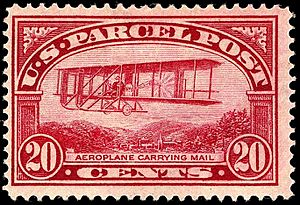
In January 1913, the Post Office started domestic parcel post service. This was a bit late, as international parcel post service between the U.S. and other countries began in 1887. A series of twelve Parcel Post stamps for this service had already been released in December 1912, with values from 1¢ to $1. All were printed in red. The lower values showed different parts of mail handling and delivery, while higher values showed industries like Manufacturing and Fruit Growing. Five green Parcel Post Postage Due stamps also appeared at the same time.
It soon became clear that these stamps weren't really needed. Regular stamps could easily pay for parcel postage, and normal postage due stamps were enough for parcels. When the original supply ran out, no more were printed, and no replacements were planned. However, one value introduced in the Parcel Post series – 20¢ – proved useful. The Post Office added this value to the Washington-Franklin issues in 1914, along with a 30¢ stamp.
On November 3, 1917, the regular letter rate increased from 2¢ to 3¢ to help with the war effort. This rate hike was reflected in the first postwar commemorative stamp – a 3¢ "victory" stamp released on March 3, 1919 (postal fees didn't return to peacetime levels until July 1). Only once before (with the Lincoln Memorial issue of 1909) had the Post Office issued a commemorative stamp not tied to a big national event. The appearance of the Pilgrim Tercentenary series in 1920 confirmed a new policy: the Post Office no longer needed a reason like a trade fair to issue commemoratives. They could now freely produce stamps celebrating the anniversaries of any notable historical figures, groups, or events.
The 1920s and 1930s Stamps
The stamps of the 1920s were mainly the Series of 1922, which was the first new design for regular stamps in a generation. The lower values mostly showed different presidents, with the 5¢ stamp especially meant to honor the recently deceased Theodore Roosevelt. The higher values included an "American Indian" (Hollow Horn Bear), the Statue of Liberty, Golden Gate (before the bridge was built), Niagara Falls, a bison, and the Lincoln Memorial. Higher values (from 17¢ to $5) were different from the cheaper stamps because they were designed horizontally (landscape) instead of vertically, an idea carried over from the "big Bens" of the Washington-Franklin series.
Stamp printing was changing from a flat plate press to a rotary press while these stamps were in use. Because of this, most come with two different perforations: 11 for flat plate, and 11x10.5 for rotary. In 1929, theft problems in the Midwest led to the Kansas-Nebraska overprints on the regular stamps.
From 1924 onwards, commemorative stamps appeared every year. The 1920s saw many 150th anniversaries related to the American Revolutionary War, and several stamps were issued for these. These included the first U.S. souvenir sheet for the Battle of White Plains 150th anniversary, and the first overprint, which read "MOLLY / PITCHER", honoring the heroine of the Battle of Monmouth.
Two Cent Red Sesquicentennial Issues (1926–1932)
During this time, the U.S. Post Office issued more than a dozen 'Two Cent Reds'. These stamps celebrated the 150th anniversaries of battles and events from the American Revolution. The first of these was the Liberty Bell 150th Anniversary Issue of 1926. The 'Two Cent Reds' were among the last stamps used to send a letter for 2 cents. The rate changed to 3 cents on July 6, 1932, and stayed that way for 26 years until it finally changed to 4 cents in 1958.
Graf Zeppelin Stamps
German zeppelins were very interesting during this time. In 1930, the Post Office issued special stamps to be used on the Pan-American flight of the Graf Zeppelin.
Even though the Graf Zeppelin stamps are highly valued by collectors today as works of art, in 1930, the recent stock market crash meant few people could afford them. The set of stamps cost $4.55, which was about a week's food money for a family of four. Less than 10% of the 1,000,000 of each stamp issued were sold, and the rest were burned. It's estimated that less than 8% of the stamps produced still exist today. They remain the smallest U.S. issue of the 20th century.
In 1932, a set of 12 stamps was issued to celebrate George Washington's 200th birthday, called the 1932 Washington Bicentennial series. For the 2¢ stamp, which was the normal letter rate, the most famous image of Washington by Gilbert Stuart was chosen. After postal rates went up that July, this 2¢ red Washington stamp was redesigned as a 3¢ stamp and issued in the purple color that became common for U.S. commemorative stamps.
The New Deal Era Stamps
In 1933, Franklin D. Roosevelt became president. He was a very enthusiastic stamp collector himself, owning about a million stamps! He also took a personal interest in the stamps the Post Office issued, working closely with Postmaster James Farley. Many stamp designs in the 1930s were inspired or changed based on Roosevelt's ideas. In 2009–10, the National Postal Museum showed six of Roosevelt's sketches that became stamps.
A steady stream of commemorative stamps appeared during these years, including a striking 1934 issue of ten stamps showing famous views of ten National Parks. This set has remained very popular. For the first time, the Post Office chose an orange color for the 2¢ Grand Canyon stamp instead of the usual 2¢ carmine red, moving away from the Universal Postal Union's color-coding rules.
With a stamp collector in the White House, the Post Office catered to collectors like never before, issuing seven separate souvenir sheets between 1933 and 1937. In one case, a special series for collectors had to be made because of a mistake. Around 1935, Postmaster Farley took sheets of the National Parks set from stock before they had glue or perforations. He gave these and unfinished examples of ten other stamps to President Roosevelt and Interior Secretary Harold L. Ickes (who was also a stamp collector) as interesting items for their collections. When people found out about these gifts, there was a public outcry. Some accused Farley of a corrupt plan to make Roosevelt and Ickes rich by creating valuable rare stamps for them at taxpayer expense. Stamp fans demanded that these special items be sold to the public so ordinary collectors could get them. Farley then issued them in large quantities. This series of special printings became known as "Farley's Follies."
As the decade went on, the purple colors used for 3¢ stamps, while still officially purple, showed a wider range of shades. One 1940 issue, a 3¢ stamp commemorating the Pony Express, didn't use purple at all, appearing in a rust-brown color that fit the image of a horse and rider.
Presidential Issue of 1938
The famous Presidential Issue, often called "Prexies" for short, came out in 1938. This series featured all 29 U.S. presidents up to Calvin Coolidge, each shown in profile as a small sculpture. Stamps with values of 50¢ and lower were single-colored. On the $1, $2, and $5 stamps, the presidents' images were printed in black on white, surrounded by colored lettering and decoration.
Up to the 22¢ Cleveland stamp, the value assigned to each president matched his number in the presidential list. For example, the first president, Washington, was on the 1¢ stamp, and the seventeenth, Andrew Johnson, was on the 17¢ stamp. Additional stamps showed Franklin (½¢), Martha Washington (1½¢), and the White House (4½¢). Many of these values were just to keep the presidents in order and didn't always match a postal rate. A fun challenge for Prexie collectors is to find a letter with, for example, a single 16¢ stamp that paid a valid combination of rates and fees during the time these stamps were used. Many such letters are still waiting to be discovered. The Presidential issue was available for many years. The Post Office didn't start replacing its values with a new series, the Liberty series, until 1954.
Famous Americans Series of 1940
In 1940, the U.S. Post Office issued a set of 35 stamps over about ten months. These stamps honored America's famous Authors, Poets, Educators, Scientists, Composers, Artists, and Inventors. Among the Educators was Booker T. Washington, who became the first African-American to be honored on a U.S. stamp. This series was printed by the Bureau of Engraving and Printing. These stamps were larger than normal regular stamps, with only 280 stamp images on each printing plate (the Presidential series had 400 images). Also notable is the red-violet color chosen for the 3¢ stamps, which was brighter than the traditional purple.
- Authors: Washington Irving - James Fenimore Cooper - Ralph Waldo Emerson - Louisa May Alcott - Samuel Clemens
- Poets: Henry Wadsworth Longfellow - John Greenleaf Whittier - James Russell Lowell - Walt Whitman - James Whitcomb Riley
- Educators: Horace Mann - Mark Hopkins - Charles W. Eliot - Frances E. Willard - Booker T. Washington
- Scientists: John James Audubon - Dr. Crawford W. Long - Luther Burbank - Dr. Walter Reed - Jane Addams
- Composers: Stephen Collins Foster - John Philip Sousa - Victor Herbert - Edward A. MacDowell - Ethelbert Nevin
- Artists: Gilbert Charles Stuart - James McNeill Whistler - Augustus Saint-Gaudens - Daniel Chester French - Frederic Remington
- Inventors: Eli Whitney - Samuel F. B. Morse - Cyrus Hall McCormick - Elias Howe - Alexander Graham Bell
World War II Stamps
During World War II, the production of new U.S. 3¢ commemorative stamps almost stopped. Among the three stamps that appeared in 1942 was the famous Win the War stamp. This stamp was used a lot, partly because of patriotism and partly because there weren't many other options. It shows an Art Deco eagle in a "V" shape for victory, surrounded by 13 stars. The eagle is holding arrows but no olive branch.
A notable set of commemorative stamps did appear in 1943–44, but these stamps, all valued at 5 cents, weren't as popular as the Win the War issue. This was the Overrun Countries series (also known as the Flag set), made to honor the thirteen nations that had been taken over by the Axis Powers.
The thirteen stamps show full-color images of the national flags of Poland, Czechoslovakia, Norway, Luxembourg, the Netherlands, Belgium, France, Greece, Yugoslavia, Albania, Austria, Denmark, and Korea. The names of the countries are written below each flag. To the left of each flag is a phoenix, which symbolizes new life. To the right is a kneeling female figure with raised arms, breaking the chains of slavery.
The stamps with flags of European countries were released from June to December 1943, while the Korea flag stamp was released in November 1944. These stamps cost 5 cents, even though the standard price for a first-class stamp was 3 cents. These stamps were meant for V-mail, a special way to send mail to military personnel overseas to make sure it got there. Service members overseas used the same method to write letters home, and their postage was free. The extra two cents on V-mail letters helped pay for this special delivery method.
Because full-color printing was complicated, the Bureau of Engraving and Printing hired a private company, the American Bank Note Company, to produce this series. These were the first U.S. stamps printed by a private company since 1893. Uniquely, these stamp sheets don't have the plate numbers usually printed around the stamps. Instead, the name of the country is engraved in capital letters where the numbers would normally be.
After World War II
After World War II, the stamp program followed a consistent pattern for many years: a steady stream of commemorative stamps sold as single stamps at the first-class letter rate. Most of these were designed in a double-width format. However, a good number of stamps honoring individuals followed the size, style, and red-violet color used in the 1940 Famous Americans series.
The Postal Service became less strict about using purple for 3¢ stamps. After the war, it became common for double-width commemorative stamps to be different colors (though U.P.U. colors and purple for 3¢ stamps continued in the regular stamp issues of the next decades). Starting in 1948, Congressional Representatives and Senators began asking the Post Office for stamps suggested by their voters. This led to a lot of stamps honoring less well-known people and groups. Stamp issues didn't become well-regulated again until the Citizens' Stamp Advisory Committee (CSAC) was formed in 1957.
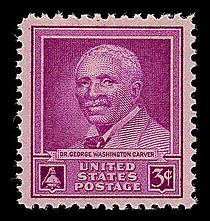
The Liberty Issue of 1954, during the Cold War, had a more political feel than previous stamps. The common first-class stamp was a 3¢ Statue of Liberty in purple, and it included the words "In God We Trust". This was the first time an explicit religious reference appeared on a U.S. stamp. The Statue of Liberty also appeared on two higher values, 8¢ and 11¢, both printed in two colors. Other stamps in the series included statesmen and landmarks related to liberty, like Patrick Henry and Bunker Hill.
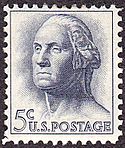
In 1957, the American Flag was featured on a U.S. stamp for the first time. The Post Office had avoided this image for a long time, fearing that people would accuse them of disrespecting the flag by putting cancellation marks on it. However, there weren't many protests against this first flag issue, and the flag has been a popular U.S. stamp subject ever since.
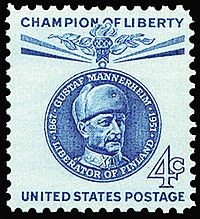
The 3¢ rate for first-class mail had been unchanged since 1932. But by 1958, there were no more ways to keep prices down, and the rate went to 4¢. This started a steady series of rate increases, reaching 49¢ by January 26, 2014.
The Prominent Americans series replaced the "Liberties" in the 1960s. This was the last regular stamp series to follow the Universal Postal Union color code. In the 1970s, they were replaced by the Americana series, where colors were chosen simply by the designer's preference.
In 1971, the Post Office was reorganized by the Postal Reorganization Act of 1970 and became the United States Postal Service (USPS). However, it is still heavily regulated. For example, the CSAC still decides which commemorative stamps to issue.
The Bicentennial Series began with a stamp showing the logo for the United States Bicentennial celebrations in 1971 and ended in 1983.
In January 1973, the USPS started issuing "Love" stamps. These were for use on Valentine's Day and other special occasions like weddings, birthdays, anniversaries, and letters to loved ones. The first such stamp was an 8-cent stamp that the Postal Service initially called "Special Stamp for Someone Special". The stamp was based on a pop art image that Robert Indiana had designed in the 1960s. The 1973 issue had 320 million stamps printed.
Air Mail Stamps
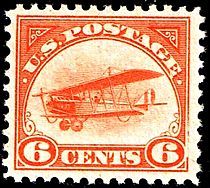
Airmail in the United States Post Office developed in three stages. First was the 'pioneer period' before 1918, when many unofficial flights carried mail. In 1918, the U.S. Post Office took over all Air Mail delivery. The U.S. Post Office then started hiring private companies to carry mail (Contract Air Mail, CAM) on February 15, 1926. In 1934, the U.S. Army carried all U.S. Air Mail for six months, after which the contract system started again.
Abraham Lincoln Stamps
In 1866, about a year after Abraham Lincoln was assassinated, the U.S. Post Office issued its first postage stamp honoring him. The Post Office said it was released on June 17. Some sources believe it was introduced on April 14, the one-year anniversary of Lincoln's death. In any case, some consider it America's first commemorative stamp. From then on, Lincoln's portrait appeared on many U.S. postage stamps, and today he is on more than a dozen issues. Lincoln is also honored on commemorative stamps issued by Costa Rica and Nicaragua. Except for George Washington and Benjamin Franklin, Lincoln appears on U.S. Postage more than any other famous American.
- Lincoln Issues
Modern U.S. Stamps
The first self-adhesive stamp was a 10-cent stamp from the Christmas issue of 1974. It wasn't considered very successful, and the stamps that still exist are slowly changing color because of the glue used. Self-adhesive stamps weren't issued again until 1989. They gradually became so popular that by 2004, only a few types of stamps were offered with the traditional glue (now jokingly called "manual stamps" by postal employees).
The increasing number of postal rate increases from the 1970s onwards, and the need to wait for Congress to approve them, made it hard for the Postal Service to provide stamps matching the new costs on time. For example, until it was known whether the new first-class rate would be 16¢ or 15¢, no stamp with a number could be printed. The Postal Service found a way around this problem in 1978. Before that year's increase, an orange stamp with a simple eagle design appeared, marked "A" instead of a number. The public was told this stamp would cover the new first-class rate, whatever it turned out to be. Later rate increases led to B, C, and D stamps, which had the same eagle design but were printed in purple, buff-brown, and blue-green, respectively. When it was time for an E stamp in 1987, the Postal Service created a more detailed design: a color picture of the globe as seen from space (E for Earth). Later increases brought F for Flower, G for Old Glory, and H for Hat stamps, all with fitting illustrations.
The Great Americans series and the Transportation coils started appearing in 1980 and 1981. The transportation coils were used steadily for about 20 years, while Great Americans was replaced by the Distinguished Americans series, which began in 2000.
The growing use of email and other technologies in the 1990s led to a decrease in first-class mail, while bulk mail increased. A wide variety of commemorative stamps continue to appear, but more of them go to collectors. The stamps used by average people for daily mail are often non-denominated types issued specifically for businesses.
The first U.S. postage stamp to use microprinting as a security feature was the American Wildflower Series, introduced by the United States Postal Service in 1992. It was also the first commemorative stamp to be completely produced by offset lithography. The USPS has since issued other stamps with more complex microprinting, including dates, words, and abbreviations like USPS, and even entire stamp designs made of microprint letters.
In 2005, after 111 years of producing American postage stamps, the Bureau of Engraving and Printing stopped its involvement with the postal service.
On April 12, 2007, the Forever stamp went on sale for 41 cents. It is good for mailing one-ounce First-Class letters anytime in the future, no matter how much prices change. In 2011, the Post Office started issuing all new stamps for First-Class postage—both regular and commemorative—as Forever stamps. They no longer included specific values on them. Starting in 2015, the Post Office made all other stamps Forever stamps too, such as Postcard, Additional Ounce, Two Ounce, Three Ounce, and Non-Machinable Surcharge stamps. These types of stamps now have their use printed on them instead of a number.
On February 25, 2010, a court ruled that Frank Gaylord, the sculptor of part of the Korean War Veterans Memorial, deserved to be paid when an image of his sculpture was used on a 37-cent postage stamp. This was because he had not given up his intellectual property rights to the sculpture. The Postal Service argued that Gaylord wasn't the only sculptor and that the sculpture was actually architecture. Gaylord won his arguments in a lower court, except for one: the court said the photo was fair use and he wasn't owed money. Gaylord appealed and won. In 2011, a court awarded Gaylord $5,000. On appeal, the case was sent back, and in September 2013, the court awarded Gaylord over $600,000 in damages.
Later in the 2010s, automated stamp and bank ATM machines started giving out thinner stamps. The thinner stamps were designed to be easier for automated machines to dispense and to be more environmentally friendly.
On January 26, 2014, the postal service raised the price of First-class postage stamps to 49 cents. Rates for other mail, including postcards and packages, also increased.
Starting in 2005, the USPS allowed customers to design and buy custom stamps through other companies. The USPS had rules about what images could not be used (like alcohol, tobacco, gambling, weapons, political content, or religious content). These rules caused some debate because they were not always applied evenly. This led to lawsuits. On June 9, 2020, a court ruled that the content rules were not clear enough. One week later, the USPS stopped the custom stamp program.
New Stamps
There are rules for new stamps and postal items. For example, "events of historical significance shall be considered for commemoration only on anniversaries in multiples of 50 years." For many years, another rule was that "no postal item will be issued sooner than five years after the individual's death," with an exception for recently deceased U.S. Presidents. However, in September 2011, the postal service announced that, to increase revenue, stamps would soon feature images of famous living people. These people would be chosen by a committee based on suggestions from the public through mail and social media. The updated rule now says: "The Postal Service will honor living men and women who have made extraordinary contributions to American society and culture."
On June 14, 2008, the Postal Service issued the first set of 10 designs in the 42-cent Flags of Our Nation stamps. Five more sets of ten stamps each appeared by August 16, 2012, bringing the total to sixty stamp designs. Sets 3 and 4 were 44-cents, while the last two sets were Forever stamps.
In August 2014, former Postmaster General Benjamin F. Bailar complained that the USPS was focusing on stamps about popular culture instead of cultural icons. He claimed this was a way to make up for the USPS's money shortage, but at the cost of the stamp program's values.
Timeline of U.S. Postal History

- 1639: First American Post Office set up in Boston.
- 1672: New York City mail service to Boston begins.
- 1674: Mail service starts in Connecticut.
- 1683: William Penn begins weekly service to Pennsylvania and Maryland towns.
- 1693: Service between colonies begins in Virginia.
- 1775: First Postmaster General appointed: Benjamin Franklin.
- 1799: U.S. Congress passes law allowing the death penalty for mail robbery.
- 1813: First mail carried by steamboat.
- 1832: First official railroad mail service.
- 1847: First U.S. postage stamps issued.
- 1857: Perforated stamps (with holes for tearing) are introduced.
- 1860: Pony Express starts.
- 1861: Mailing of post cards is allowed.
- 1873: Pre-stamped "postal cards" are introduced.
- 1879: Postage due stamps are introduced.
- 1885: Special Delivery service begins.
- 1893: First commemorative event stamps are issued for the World's Columbian Exposition in Chicago.
- 1913: Domestic parcel post delivery begins.
- 1918: First airmail stamps are introduced.
- 1920: Transcontinental mail service between New York City and San Francisco begins.
- 1955: Certified Mail service is introduced.
- 1958: Well-known artists begin designing stamps.
- 1963: 5-digit ZIP Codes are introduced.
- 1983: ZIP + 4 code is introduced.
- 1989: Priority Mail is introduced.
- 1992: Microprint is introduced, and the first commemorative stamp is developed entirely by offset lithography.
- 1997: Special Delivery service is stopped.
- 2007: Forever stamps are introduced.
See also
 In Spanish: Historia postal de Estados Unidos para niños
In Spanish: Historia postal de Estados Unidos para niños


